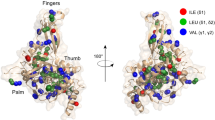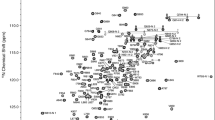Abstract
Deubiquitinase USP20/VDU2 has been identified as a regulator of multiple proteins including hypoxia-inducible factor (HIF)-1α, β2-adrenergic receptor, and tumor necrosis factor receptor associated factor 6 etc. It contains four structural domains, including an N-terminal zinc-finger ubiquitin binding domain (ZnF-UBP) that potentially helps USP20 to recruit its ubiquitin substrates. Here we report the 1H, 13C and 15N backbone and side-chain resonance assignments of the ZnF-UBP domain of USP20/VDU2. The BMRB accession number is 26901. The secondary structural elements predicted from the NMR data reveal a global fold consisting of three α-helices and four β-strands. The complete assignments can be used to explore the protein dynamics of the USP20 ZnF-UBP and its interactions with monoubiquitin and ubiquitin chains.


Similar content being viewed by others
References
Berthouze M, Venkataramanan V, Li Y, Shenoy SK (2009) The deubiquitinases USP33 and USP20 coordinate beta2 adrenergic receptor recycling and resensitization. EMBO J 28(12):1684–1696. doi:10.1038/emboj.2009.128
Bonnet J, Romier C, Tora L, Devys D (2008) Zinc-finger UBPs: regulators of deubiquitylation. Trends Biochem Sci 33(8):369–375. doi:10.1016/j.tibs.2008.05.005
Chen ZJ, Sun LJ (2009) Nonproteolytic functions of ubiquitin in cell signaling. Mol Cell 33(3):275–286. doi:10.1016/j.molcel.2009.01.014
Clague MJ, Urbe S (2010) Ubiquitin: same molecule, different degradation pathways. Cell 143(5):682–685. doi:10.1016/j.cell.2010.11.012
Curcio-Morelli C, Zavacki AM, Christofollete M, Gereben B, de Freitas BC, Harney JW, Li Z, Wu G, Bianco AC (2003) Deubiquitination of type 2 iodothyronine deiodinase by von Hippel-Lindau protein-interacting deubiquitinating enzymes regulates thyroid hormone activation. J Clin Invest 112(2):189–196. doi:10.1172/JCI18348
Delaglio F GS, Vuister GW, Zhu G, Pfeifer J, Bax A (1995) NMRPipe: a multidimensional spectral processing system based on UNIX pipes. J Biomol NMR 6:277–293
Fraile JM, Quesada V, Rodriguez D, Freije JM, Lopez-Otin C (2012) Deubiquitinases in cancer: new functions and therapeutic options. Oncogene 31(19):2373–2388. doi:10.1038/onc.2011.443
Glickman MH, Ciechanover A (2002) The ubiquitin-proteasome proteolytic pathway: destruction for the sake of construction. Physiol Rev 82(2):373–428. doi:10.1152/physrev.00027.2001
Haglund K, Dikic I (2005) Ubiquitylation and cell signaling. EMBO J 24(19):3353–3359. doi:10.1038/sj.emboj.7600808
Keller RLJ (2004) The computer aided resonance assignment tutorial. CANTINA Verlag, Goldau
Kim SR, Kim JO, Lim KH, Yun JH, Han I, Baek KH (2015) Regulation of pyruvate kinase isozyme M2 is mediated by the ubiquitin-specific protease 20. Int J Oncol 46(5):2116–2124. doi:10.3892/ijo.2015.2901
Komander D, Clague MJ, Urbe S (2009) Breaking the chains: structure and function of the deubiquitinases. Nat Rev Mol Cell Biol 10(8):550–563. doi:10.1038/nrm2731
Li Z, Na X, Wang D, Schoen SR, Messing EM, Wu G (2002a) Ubiquitination of a novel deubiquitinating enzyme requires direct binding to von Hippel-Lindau tumor suppressor protein. J Biol Chem 277(7):4656–4662. doi:10.1074/jbc.M108269200
Li Z, Wang D, Na X, Schoen SR, Messing EM, Wu G (2002b) Identification of a deubiquitinating enzyme subfamily as substrates of the von Hippel-Lindau tumor suppressor. Biochem Biophys Res Commun 294(3):700–709. doi:10.1016/S0006-291X(02)00534-X
Li Z, Wang D, Messing EM, Wu G (2005) VHL protein-interacting deubiquitinating enzyme 2 deubiquitinates and stabilizes HIF-1alpha. EMBO Rep 6(4):373–378. doi:10.1038/sj.embor.7400377
Sacco JJ, Coulson JM, Clague MJ, Urbe S (2010) Emerging roles of deubiquitinases in cancer-associated pathways. IUBMB Life 62(2):140–157. doi:10.1002/iub.300
Searle MS, Garner TP, Strachan J, Long J, Adlington J, Cavey JR, Shaw B, Layfield R (2012) Structural insights into specificity and diversity in mechanisms of ubiquitin recognition by ubiquitin-binding domains. Biochem Soc Trans 40(2):404–408. doi:10.1042/BST20110729
Shanmugam I, Abbas M, Ayoub F, Mirabal S, Bsaili M, Caulder EK, Weinstock DM, Tomkinson AE, Hromas R, Shaheen M (2014) Ubiquitin-specific peptidase 20 regulates Rad17 stability, checkpoint kinase 1 phosphorylation and DNA repair by homologous recombination. J Biol Chem 289(33):22739–22748. doi:10.1074/jbc.M114.550459
Wishart DS, Sykes BD, Richards FM (1992) The chemical shift index: a fast and simple method for the assignment of protein secondary structure through NMR spectroscopy. BioChemistry 31(6):1647–1651
Yasunaga J, Lin FC, Lu X, Jeang KT (2011) Ubiquitin-specific peptidase 20 targets TRAF6 and human T cell leukemia virus type 1 tax to negatively regulate NF-kappaB signaling. J Virol 85(13):6212–6219. doi:10.1128/JVI.00079-11
Acknowledgements
This work was funded by the National Natural Science Foundation of China (Grant Numbers 21272246 to N. Z. and 31300608 to Y. W.) and the National Key Basic Research Program of China (Grant Number 2013CB910900 to N. Z.).
Author information
Authors and Affiliations
Corresponding authors
Rights and permissions
About this article
Cite this article
Yang, Y., Wen, Y. & Zhang, N. 1H, 13C and 15N backbone and side-chain resonance assignments of the ZnF-UBP domain of USP20/VDU2. Biomol NMR Assign 11, 91–93 (2017). https://doi.org/10.1007/s12104-017-9726-y
Received:
Accepted:
Published:
Issue Date:
DOI: https://doi.org/10.1007/s12104-017-9726-y




